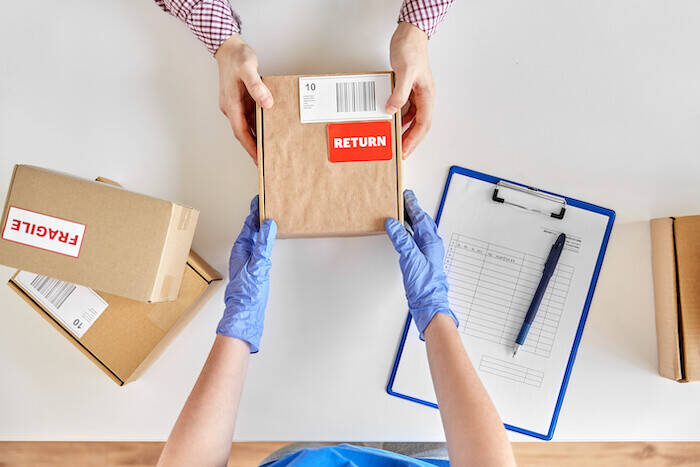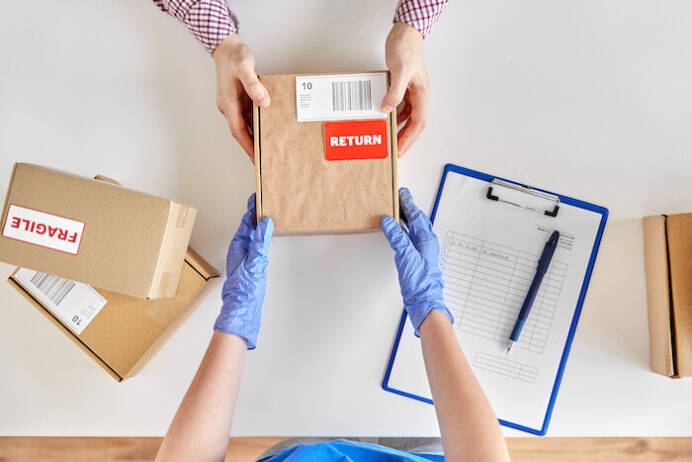Home > About the eBook > Table of Contents > Returns > When Returns Get You Down - An eCommerce Survival Tale



I hate returns, you hate returns. But you know who really hates returns, even more than us? eTailers.
Nothing’s worse than having to deal with the dreaded return label when you need to return an item bought online. The label must be located, usually through searching your inbox for an email with a link or a printable label.
Sometimes I wonder: Why do I have to jump through this many hoops to deal with a return?!
OK, we’ve established…nobody likes returns. So why are we even talking about them?
Industry experts say that as much as 30 percent of online purchases are returned. It’s gotten to the point that Amazon & Walmart are crediting purchasers of inexpensive items with a full refund, telling them to simply keep the items. Did any of you see that coming?
We’ve touched on this issue in the past, but with returns continuing to be a problem for so many eCommerce brands, we thought it was time for a more in-depth look.
You know the basics: recent shopping trends have stalled the in-store shopping experience and online sales orders have skyrocketed.
Business is good for many eTailers, and retailers are ramping up their eCommerce operation to include better user-experiences and more omnichannel options for consumers. If you sell consumables or products with a limited opportunity for returns, maybe you haven’t been quite as impacted by the tidal wave of returns, but if you sell clothing or any other products that consumers can easily use the dreaded Bracketing strategy on (Bracketing is the practice of customers ordering a range of sizes, colors, etc., with the full intention of returning any products they don’t love), it’s likely you’re feeling the pain of returns.
Let us look at the returns experience from the perspective of consumers and brands:
Consumers – returns are made for a variety of reasons, including:
No longer want the item
Delivery took too long
Poor quality or not as described
Damaged
Received wrong item
Ordered multiple sizes/types of the item, returning unwanted units
Fraud – item is used or worn and returned but was sold “as new”
Brands – an entirely different set of dynamics applies for eCommerce brands, as they need to:
Process returns though a labor-intensive process involving CSR’s, warehouse staff & finance
Shipping costs back to origin are often involved
A credit must be issued to the consumer
Goods must be inspected for damage and classified if they can be resold or should be destroyed
Saleable goods must repacked for sale
Damaged goods must sent for destruction
Find some great data and infographics on why goods are returned and the impact on Brands.
Now that you understand the underlying causes of returns, and the bottlenecks in handling them, what can you do to seamlessly handle all those returns you’re getting?
Regardless of what the reason is that an item is returned, it still represents a burden on any eTailer. And, more importantly, at the end of the day, it’s a loss of profit. A terrific, in depth analysis of returns, processing and guide to building a returns policy is available at Easyship.
To manage the process to the benefit consumers and Brands is no easy process. Your goal should be to:
Start by displaying your returns policy
Don’t have a policy? Write one! Your returns policy should be written in a way that doesn’t sound like the fine print on an insurance policy (translation: make it clear and easy-to-understand
Handle the return as painlessly as possible for the consumer & your staff – if your process is eighteen steps long, then your customers and your employees are probably tired of the experience
Encourage repeat business from customers you want to retain – figure out those you need to jettison
Identify serial “returners” or cases of fraud
Incorporate customer reviews that speak to the quality of the product and of their excellent buying experience
Dive into the metrics and data that can help you identify frequently returned items. You can analyze things such as:
Do the product descriptions accurately describe the attributes and use of the product?
Is misinformation contributing to returns?
Do images clearly portray products?
Do images contribute to consumer confidence and satisfaction?
Are products sized correctly?
Can consumers feel confident about the fit or within the parameters of expected use? IE: Does that shirt flatter? Is that table narrower than advertised?
Does your product packaging stand up to the stress of shipping? Or does it break under pressure?
Of course, you also need a great order and inventory management system (OMS) to help and while M.O.M. v12 is already a master at managing the returns desk, we’re always looking to improve.
Share your experiences with us, and we promise not to return those new shirts we bought.
Reach out today! Contact us to find out how M.O.M. can help you better manage your returns and streamline your order and inventory management processes.

I hate returns, you hate returns. But you know who really hates returns, even more than us? eTailers.
Nothing’s worse than having to deal with the dreaded return label when you need to return an item bought online. The label must be located, usually through searching your inbox for an email with a link or a printable label.
Sometimes I wonder: Why do I have to jump through this many hoops to deal with a return?!
OK, we’ve established…nobody likes returns. So why are we even talking about them?
Industry experts say that as much as 30 percent of online purchases are returned. It’s gotten to the point that Amazon & Walmart are crediting purchasers of inexpensive items with a full refund, telling them to simply keep the items. Did any of you see that coming?
We’ve touched on this issue in the past, but with returns continuing to be a problem for so many eCommerce brands, we thought it was time for a more in-depth look.
You know the basics: recent shopping trends have stalled the in-store shopping experience and online sales orders have skyrocketed.
Business is good for many eTailers, and retailers are ramping up their eCommerce operation to include better user-experiences and more omnichannel options for consumers. If you sell consumables or products with a limited opportunity for returns, maybe you haven’t been quite as impacted by the tidal wave of returns, but if you sell clothing or any other products that consumers can easily use the dreaded Bracketing strategy on (Bracketing is the practice of customers ordering a range of sizes, colors, etc., with the full intention of returning any products they don’t love), it’s likely you’re feeling the pain of returns.
Let us look at the returns experience from the perspective of consumers and brands:
Consumers – returns are made for a variety of reasons, including:
No longer want the item
Delivery took too long
Poor quality or not as described
Damaged
Received wrong item
Ordered multiple sizes/types of the item, returning unwanted units
Fraud – item is used or worn and returned but was sold “as new”
Brands – an entirely different set of dynamics applies for eCommerce brands, as they need to:
Process returns though a labor-intensive process involving CSR’s, warehouse staff & finance
Shipping costs back to origin are often involved
A credit must be issued to the consumer
Goods must be inspected for damage and classified if they can be resold or should be destroyed
Saleable goods must repacked for sale
Damaged goods must sent for destruction
Find some great data and infographics on why goods are returned and the impact on Brands.
Now that you understand the underlying causes of returns, and the bottlenecks in handling them, what can you do to seamlessly handle all those returns you’re getting?
Regardless of what the reason is that an item is returned, it still represents a burden on any eTailer. And, more importantly, at the end of the day, it’s a loss of profit. A terrific, in depth analysis of returns, processing and guide to building a returns policy is available at Easyship.
To manage the process to the benefit consumers and Brands is no easy process. Your goal should be to:
Start by displaying your returns policy
Don’t have a policy? Write one! Your returns policy should be written in a way that doesn’t sound like the fine print on an insurance policy (translation: make it clear and easy-to-understand
Handle the return as painlessly as possible for the consumer & your staff – if your process is eighteen steps long, then your customers and your employees are probably tired of the experience
Encourage repeat business from customers you want to retain – figure out those you need to jettison
Identify serial “returners” or cases of fraud
Incorporate customer reviews that speak to the quality of the product and of their excellent buying experience
Dive into the metrics and data that can help you identify frequently returned items. You can analyze things such as:
Do the product descriptions accurately describe the attributes and use of the product?
Is misinformation contributing to returns?
Do images clearly portray products?
Do images contribute to consumer confidence and satisfaction?
Are products sized correctly?
Can consumers feel confident about the fit or within the parameters of expected use? IE: Does that shirt flatter? Is that table narrower than advertised?
Does your product packaging stand up to the stress of shipping? Or does it break under pressure?
Of course, you also need a great order and inventory management system (OMS) to help and while M.O.M. v12 is already a master at managing the returns desk, we’re always looking to improve.
Share your experiences with us, and we promise not to return those new shirts we bought.
Reach out today! Contact us to find out how M.O.M. can help you better manage your returns and streamline your order and inventory management processes.